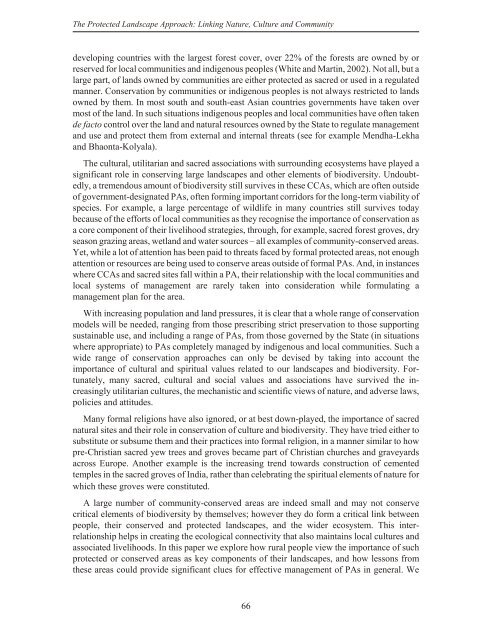The Protected Landscape Approach - Centre for Mediterranean ...
The Protected Landscape Approach - Centre for Mediterranean ...
The Protected Landscape Approach - Centre for Mediterranean ...
Create successful ePaper yourself
Turn your PDF publications into a flip-book with our unique Google optimized e-Paper software.
<strong>The</strong> <strong>Protected</strong> <strong>Landscape</strong> <strong>Approach</strong>: Linking Nature, Culture and Community<br />
developing countries with the largest <strong>for</strong>est cover, over 22% of the <strong>for</strong>ests are owned by or<br />
reserved <strong>for</strong> local communities and indigenous peoples (White and Martin, 2002). Not all, but a<br />
large part, of lands owned by communities are either protected as sacred or used in a regulated<br />
manner. Conservation by communities or indigenous peoples is not always restricted to lands<br />
owned by them. In most south and south-east Asian countries governments have taken over<br />
most of the land. In such situations indigenous peoples and local communities have often taken<br />
de facto control over the land and natural resources owned by the State to regulate management<br />
and use and protect them from external and internal threats (see <strong>for</strong> example Mendha-Lekha<br />
and Bhaonta-Kolyala).<br />
<strong>The</strong> cultural, utilitarian and sacred associations with surrounding ecosystems have played a<br />
significant role in conserving large landscapes and other elements of biodiversity. Un doubt -<br />
edly, a tremendous amount of biodiversity still survives in these CCAs, which are often outside<br />
of government-designated PAs, often <strong>for</strong>ming important corridors <strong>for</strong> the long-term viability of<br />
species. For example, a large percentage of wildlife in many countries still survives today<br />
because of the ef<strong>for</strong>ts of local communities as they recognise the importance of conservation as<br />
a core component of their livelihood strategies, through, <strong>for</strong> example, sacred <strong>for</strong>est groves, dry<br />
season grazing areas, wetland and water sources – all examples of community-conserved areas.<br />
Yet, while a lot of attention has been paid to threats faced by <strong>for</strong>mal protected areas, not enough<br />
attention or resources are being used to conserve areas outside of <strong>for</strong>mal PAs. And, in instances<br />
where CCAs and sacred sites fall within a PA, their relationship with the local communities and<br />
local systems of management are rarely taken into consideration while <strong>for</strong>mulating a<br />
management plan <strong>for</strong> the area.<br />
With increasing population and land pressures, it is clear that a whole range of conservation<br />
models will be needed, ranging from those prescribing strict preservation to those supporting<br />
sustainable use, and including a range of PAs, from those governed by the State (in situations<br />
where appropriate) to PAs completely managed by indigenous and local communities. Such a<br />
wide range of conservation approaches can only be devised by taking into account the<br />
importance of cultural and spiritual values related to our landscapes and biodiversity. For -<br />
tunately, many sacred, cultural and social values and associations have survived the in -<br />
creasingly utilitarian cultures, the mechanistic and scientific views of nature, and adverse laws,<br />
policies and attitudes.<br />
Many <strong>for</strong>mal religions have also ignored, or at best down-played, the importance of sacred<br />
natural sites and their role in conservation of culture and biodiversity. <strong>The</strong>y have tried either to<br />
substitute or subsume them and their practices into <strong>for</strong>mal religion, in a manner similar to how<br />
pre-Christian sacred yew trees and groves became part of Christian churches and graveyards<br />
across Europe. Another example is the increasing trend towards construction of cemented<br />
temples in the sacred groves of India, rather than celebrating the spiritual elements of nature <strong>for</strong><br />
which these groves were con stituted.<br />
A large number of community-conserved areas are indeed small and may not conserve<br />
critical elements of biodiversity by themselves; however they do <strong>for</strong>m a critical link between<br />
people, their conserved and protected landscapes, and the wider ecosystem. This interrelationship<br />
helps in creating the ecological connectivity that also maintains local cultures and<br />
associated livelihoods. In this paper we explore how rural people view the importance of such<br />
protected or conserved areas as key components of their landscapes, and how lessons from<br />
these areas could provide significant clues <strong>for</strong> effective management of PAs in general. We<br />
66

















